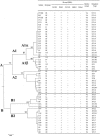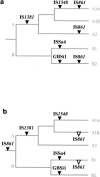Acquisition of insertion sequences and the GBSi1 intron by Streptococcus agalactiae isolates correlates with the evolution of the species
- PMID: 16109968
- PMCID: PMC1196170
- DOI: 10.1128/JB.187.17.6248-6252.2005
Acquisition of insertion sequences and the GBSi1 intron by Streptococcus agalactiae isolates correlates with the evolution of the species
Abstract
The prevalence of insertion sequences IS1548, IS861, IS1381, and ISSa4 and of the group II intron GBSi1 within Streptococcus agalactiae human isolates strongly correlates with the genetic lineages obtained by multilocus sequence typing. Our results yielded an evolutionary scheme for the acquisition of these genetic elements linked to the ecosystems from which the isolates were obtained.
Figures


Similar articles
-
Mutually exclusive distribution of IS1548 and GBSi1, an active group II intron identified in human isolates of group B streptococci.J Bacteriol. 2001 Apr;183(8):2560-9. doi: 10.1128/JB.183.8.2560-2569.2001. J Bacteriol. 2001. PMID: 11274116 Free PMC article.
-
Molecular characterization of erythromycin-resistant Streptococcus agalactiae strains.J Antimicrob Chemother. 2008 Dec;62(6):1227-33. doi: 10.1093/jac/dkn388. Epub 2008 Sep 11. J Antimicrob Chemother. 2008. PMID: 18786936
-
An inserted DNA fragment with plasmid features is uniquely associated with the presence of the GBSi1 group II intron in Streptococcus agalactiae.Gene. 2003 Jul 17;312:305-12. doi: 10.1016/s0378-1119(03)00634-6. Gene. 2003. PMID: 12909368
-
Intron-rich ancestors.Trends Genet. 2006 Sep;22(9):468-71. doi: 10.1016/j.tig.2006.07.002. Epub 2006 Jul 20. Trends Genet. 2006. PMID: 16857287 Review.
-
Yeasts illustrate the molecular mechanisms of eukaryotic genome evolution.Trends Genet. 2006 Jul;22(7):375-87. doi: 10.1016/j.tig.2006.05.007. Epub 2006 May 30. Trends Genet. 2006. PMID: 16730849 Review.
Cited by
-
Clinical features of group B Streptococcus prosthetic joint infections and molecular characterization of isolates.J Clin Microbiol. 2011 Jan;49(1):380-2. doi: 10.1128/JCM.00581-10. Epub 2010 Nov 10. J Clin Microbiol. 2011. PMID: 21068273 Free PMC article.
-
Identification of an unusual pattern of global gene expression in group B Streptococcus grown in human blood.PLoS One. 2009 Sep 23;4(9):e7145. doi: 10.1371/journal.pone.0007145. PLoS One. 2009. PMID: 19774088 Free PMC article.
-
Capsular Type, Sequence Type and Microbial Resistance Factors Impact on DNase Activity of Streptococcus agalactiae Strains from Human and Bovine Origin.Eur J Microbiol Immunol (Bp). 2018 Dec 11;8(4):149-154. doi: 10.1556/1886.2018.00026. eCollection 2018 Dec 23. Eur J Microbiol Immunol (Bp). 2018. PMID: 30719332 Free PMC article.
-
Mobile genetic elements provide evidence for a bovine origin of clonal complex 17 of Streptococcus agalactiae.Appl Environ Microbiol. 2007 Jul;73(14):4668-72. doi: 10.1128/AEM.02604-06. Epub 2007 May 25. Appl Environ Microbiol. 2007. PMID: 17526784 Free PMC article.
-
Emergence and global dissemination of host-specific Streptococcus agalactiae clones.mBio. 2010 Aug 24;1(3):e00178-10. doi: 10.1128/mBio.00178-10. mBio. 2010. PMID: 20824105 Free PMC article.
References
-
- Bidet, P., N. Brahimi, C. Chalas, Y. Aujard, and E. Bingen. 2003. Molecular characterization of serotype III group B-streptococcus isolates causing neonatal meningitis. J. Infect. Dis. 188:1132-1137. - PubMed
-
- Glaser, P., C. Rusniok, C. Buchrieser, F. Chevalier, L. Frangeul, T. Msadek, M. Zouine, E. Couve, L. Lalioui, C. Poyart, P. Trieu-Cuot, and F. Kunst. 2002. Genome sequence of Streptococcus agalactiae, a pathogen causing invasive neonatal disease. Mol. Microbiol. 45:1499-1513. - PubMed
MeSH terms
Substances
LinkOut - more resources
Full Text Sources

